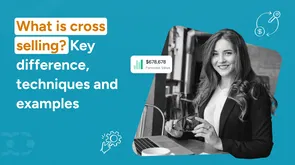Imagine stepping onto the stage, the spotlight hits, and the audience waits with bated breath. This is your moment—not just to perform, but to engage.
In the world of sales, the discovery meeting is your opening act, the vital touchpoint where opportunities are uncovered and relationships are forged.
As a sales professional, mastering the discovery session isn’t just a skill; it’s an art form that can set the stage for enduring success.
Our guide will help you conduct effective discovery meetings, starting from setting a discovery session agenda to conducting follow-ups strategically.
Furthermore, we’ll share our tried and tested discovery session template with you, offering deeper insights to understand your potential clients better.
So, let’s dive deep in.
What is a discovery meeting?
A discovery meeting is a strategic conversation aimed at uncovering a potential client’s needs, challenges, and goals. It is an essential part of the sales qualification process.
The success of this session depends on the sales representative's ability to qualify marketing qualified leads (MQLs) as viable sales opportunities.
During this initial meeting, sales professionals ask relevant sales-qualifying questions to understand the prospect’s needs and objectives.
Active listening plays a key role in gathering insights about the prospect’s intent to buy.
The information shared in a discovery meeting helps in crafting a customized, compelling proposal tailored to the prospect’s specific situation.
Here’s what a productive sales discovery meeting looks like:
There can be multiple discovery meetings based on the level of discussion required to understand your prospect’s needs and goals.
These sessions serve as the foundation for building strong business relationships.
Role of a discovery meeting in the sales qualification process
The discovery meeting is a crucial step in converting an MQL into a sales opportunity.
An MQL (Marketing Qualified Lead) represents a potential customer exploring solutions but not yet ready to make a purchase.
Through the discovery process, sales reps determine whether these MQLs should be classified as SQLs or DQLs for further engagement.
- MQLs (Marketing Qualified Leads) – Leads identified by marketing teams based on engagement and interest, showing initial potential.
- SQLs (Sales Qualified Leads) – Leads demonstrating a strong buying intent, making them ready for direct sales engagement.
- DQLs (Disqualified Leads) – Leads that do not meet sales criteria, often due to budget, authority, or lack of need, making them unsuitable for current sales efforts.
While SQLs and DQLs are part of the lead qualification process, another critical category is PQL (Product Qualified Lead). To learn more about the differences, check out our blog on MQL vs SQL vs PQL.
The discovery meeting plays a key role in qualifying an MQL into a sales opportunity. Here’s how the process unfolds:
1. It all starts with a call
When marketing hands over a lead, it becomes an MQL.
This signals potential interest in your offering. The first step? Connect with the lead to initiate a conversation and set up a discovery meeting.
2. Why does the discovery meeting matter?
Once a meeting is scheduled, this is where you dive deeper.
It’s an opportunity to uncover the lead’s needs and assess whether they qualify as an SQL or a DQL.
- Asking the right questions:
During the discovery meeting, your goal is to ask targeted questions that reveal valuable insights:
A. What specific challenges are they facing?
B. What goals are they trying to achieve?
C. What led them to consider your product?
Active listening is key to understanding and qualifying the lead.
- Use a framework for structured qualification:
Utilizing sales qualification frameworks helps streamline the process and assess readiness for your solution.
3. Necessary follow-up actions
After qualifying MQLs, sales reps tailor their next steps based on the lead type.
For SQLs, this includes personalized engagement through presentations, proposals, or negotiations.
DQLs are either nurtured for future opportunities or removed from active pipelines to focus resources on high-potential leads.
The discovery meeting provides essential information to determine whether a lead is a genuine opportunity.
How to prepare for successful discovery meetings – 7 key steps
Attending a discovery session isn’t enough; preparation is key.
According to a survey, preparation time for discovery meetings ranges from 30 minutes to two days, depending on client needs and sales experience.
A well-structured approach, in-depth research, and strategic preparation can make a significant impact.
Here’s a step-by-step guide to preparing for a successful discovery meeting:
1. Research thoroughly about your prospects and their business
Start by analyzing the potential client’s website, reviewing press releases, and studying industry reports.
Understand their product lines, services, and customer base. Being aware of industry challenges, key players, and emerging trends is essential.
Thorough research strengthens your credibility and helps uncover deeper insights into your prospect’s needs.
2. Define clear objectives for the discovery session
The primary objectives of a discovery meeting include:
- Understanding the prospect’s needs
- Identifying their pain points
- Assessing their readiness to buy
- Building rapport with the prospect
Setting clear objectives ensures productive discussions and aligns the meeting with business goals.
3. Prepare open-ended qualifying questions
Formulate questions that encourage thoughtful responses rather than simple yes/no answers.
Examples include:
- “Can you describe a challenge you’re currently facing?”
- “What strategies have you tried so far?”
- “What factors are influencing your decision-making process?”
These questions help uncover valuable insights about the prospect's needs and decision-making process.
4. Involve the right people in the meeting
Each participant should have a defined role:
- One person leads the conversation.
- Another takes detailed notes.
- Others provide technical or product-specific insights.
A structured approach ensures a well-coordinated and productive meeting.
5. Ensure a comfortable meeting environment
A relaxed prospect is more likely to engage in the discussion.
- For in-person meetings, choose a quiet space with comfortable seating.
- For virtual meetings, ensure a stable internet connection, clear audio, and proper lighting.
6. Develop a structured discovery meeting agenda
An agenda helps keep the conversation on track and covers essential discussion points:
- Introduction and setting expectations
- Understanding the prospect’s challenges and goals
- Asking relevant qualifying questions
- Discussing potential solutions
- Next steps and follow-up actions
A well-defined agenda ensures a smooth and effective meeting.
7. Be ready to address all potential doubts
Prospects prefer engaging with someone who understands their challenges and can clearly explain solutions.
Prepare simple, relatable explanations to clarify complex ideas and ease any concerns they may have.
Streamline your sales process!
See how Salesmate CRM can optimize your discovery meetings and lead follow-ups.
Best discovery meeting questions to include in your next session
Asking the right questions during a discovery call can turn a simple conversation into a goldmine of insights.
Studies show that top-performing sales professionals ask 40% more questions during discovery conversations than others. This leads to a deeper understanding of the client’s needs and challenges.
Here’s an example of a strong discovery question:
“Can you walk me through your current processes related to [specific area relevant to your solution]?”
This question allows the prospect to provide a detailed overview of their operations, making it easier to position your product as a solution.
Another key question is:
“What criteria will you use to evaluate potential solutions?”
The answer helps you structure your proposal to align with their decision-making process.
Want more questions like these? Explore our guide on sales discovery questions for deeper insights.
Discovery meeting template for a winning session
A discovery meeting template helps standardize the process across your team, ensuring each session is structured and productive.
Below is a template covering both the meeting structure and agenda:
Meeting Title: [Meeting with prospect’s name/company name]
Date and Time: [Insert date and time]
Location: [Insert location or video call link]
Duration: [Insert expected duration]
Participants:
- [Name], [Title], [Role in meeting]
- [Name], [Title], [Role in meeting]
- [Add more participants as needed]
Objective:
Gain a comprehensive understanding of [Prospect’s name/Company name]’s business needs, challenges, and goals to determine how our solutions can add value.
Pre-meeting Preparation:
- Research prospect background, industry trends, and potential pain points.
- Review past interactions or communications with the prospect.
- Prepare a list of tailored questions based on research.
- Send an agenda to the prospect for confirmation or input.
Agenda:
1. Introduction (5 mins)
- Welcome and introductions
- Overview of meeting objectives
2. Prospect’s Business Overview (10 mins)
- Prospect shares insights about their company, mission, and key initiatives
- Discussion on market position, competitors, and industry trends
3. Current State Assessment (15 mins)
- Understand the prospect’s current processes, challenges, and pain points
- Explore how these challenges impact their business goals
4. Solution Exploration (10 mins)
- Discuss potential solutions and approaches
- Share success stories or case studies relevant to their industry
5. Collaborative Discussion (15 mins)
- Address any questions or concerns from the prospect
- Discuss potential strategies and align on expectations
6. Next Steps & Action Items (5 mins)
- Outline next steps following the meeting
- Define responsibilities and timelines
7. Wrap-up (5 mins)
- Summarize key insights from the meeting
- Confirm follow-up actions and express appreciation
Post-meeting Action Items:
[List tasks, responsible parties, and deadlines]
Notes Section:
[Space for additional notes and observations]
Follow-up Plan:
Detail who will follow up, via which channel, and when.
Tip – You can easily customize the discovery session template to fit each of your meeting’s unique contexts.
Want to know more about your sales success?
With Salesmate, you can get insights into your sales that will help you optimize your strategy and grow revenue.
10 Proven tips for leading a productive discovery meeting
These tips will help you avoid common mistakes during discovery sessions, ensuring an impressive first session and thus building a strong foundation for a successful sales process.
Let’s dive deep in:
1. Start with a personal touch
Like a first date, use the opening minutes of the discovery session to establish rapport. Try to show interest in the prospect behind the business to lay the groundwork for a meaningful conversation.
Your research on the prospects will help you ask interesting questions about their business, demonstrating your expertise and concern for their needs.
2. Ease into industry talk
Begin with a discussion on common industry challenges. This not only demonstrates your understanding of their sector but also paves the way for how your services can offer solutions.
3. Ask open-ended questions
Use open-ended questions to delve into the prospect’s specific needs.
Tailor your inquiries to uncover their unique challenges, ensuring you build trust and establish yourself as a thoughtful listener.
4. Engage with active listening during your discovery sessions
A study reveals that active listening can lead to an 8% improvement in sales performance. So, embrace active listening – be present, give mutual respect, and respond thoughtfully.
This encourages the prospect to share their biggest challenge, allowing you to tailor the best solution.
5. Read the room
Be attentive to the prospect’s non-verbal cues and adjust your approach to find common ground. This can transform the dynamic of the session, especially when other prospects might not take this extra step.
6. Concise value proposition
Can you concisely express your value that meets your prospect’s need? Ensure that your potential customers see the alignment between your offerings and their needs, leaving the meeting on a positive note.
7. Welcome and address objections
View objections as opportunities for deeper engagement. Tackle them confidently, showing that you value their concerns and are prepared with clear, compelling responses.
8. Set clear next steps
End your session with everyone knowing the exact next steps—whether that’s scheduling a product demo, a follow-up call, or sending over a free template for their review.
9. Encourage dialogue
Foster a two-way conversation. A successful discovery meeting is one where the prospect feels engaged and heard.
10. Document the discussion
Documenting your conversation helps you capture the nuances of the prospect’s problems and the important details of their requirements, ensuring you’re in a better position for the next engagement.
By integrating these tips into your discovery meeting strategy, you can transform an ordinary sales interaction into an opportunity for meaningful engagement and long-term potential client relationships.
Experience endless growth with Salesmate!
Effortless lead management, sales-growth tools, and more.
1. Send a thank you note
Promptness is crucial, so make sure to send a thank-you email expressing appreciation for the prospect’s valuable time and information shared within 24 hours of the meeting.
Furthermore, this reaffirms your interest in the relationship.
2. Debrief with your team
After the meeting, debrief with your team to discuss successes, areas for improvement, and key prospect takeaways.
Make sure to consolidate any notes, observations, and commitments made during the meeting. Using an AI meeting minutes generator can help automate this process, ensuring that all important details are captured accurately and efficiently for easy reference later.
3. Address any outstanding questions
Suppose there were questions from the prospect that you couldn’t answer on the spot; address them in your follow-up email. Provide clear and thorough answers.
If further research is needed, acknowledge the question and provide a project timeline for when you can deliver the information.
4. Outline the next steps in your follow-ups
If another meeting is needed, suggest possible times and dates. If you promised to send additional information or a proposal, state when they can expect to receive it.
This clarity helps maintain momentum and keeps both parties aligned on the process.
5. Include relevant documentation
Attach any relevant documents that were promised during the meeting, such as case studies, product information, or a roadmap for implementation.
Ensure these documents are easy to read and professional as they represent your brand.
Never miss a follow-up!
Learn how Salesmate CRM can help you automate your follow-ups to close deals faster.
Conclusion
A discovery meeting is more than just a conversation. It’s the bridge between understanding a prospect’s needs and providing tailored solutions.
By ensuring you are well-prepared, asking the right discovery questions, and diligently following up, you’re setting the stage for a fruitful business relationship.
In addition, involving your project team in meeting planning, defining the project scope, and focusing on the desired outcome ensures productive and successful discovery meetings.
Invest in technology like CRM and automation, as it can help you conduct timely follow-ups, improve sales interactions, automate sales, and more.
Want to witness the growth? Take Salesmate 15 days free trial now!
What is a discovery session?
A discovery session, often termed a discovery meeting, is an initial conversation between a professional (often in sales, consulting, or project management) and a potential client. The primary goal is to understand the prospect’s needs, challenges, goals, and expectations.
What are the goals of a discovery meeting?
The main objectives of a discovery meeting include:
- Gaining a deep understanding of the prospect’s pain points and requirements.
- Setting clear expectations for both parties involved.
- Establishing rapport and building a foundation for a potentially long-term business relationship.
- Identifying opportunities for collaboration or offering solutions.
What is the structure of a discovery meeting?
A typical structure of a discovery session involves:
- Introduction: Brief introductions of attendees.
- Potential client background: Understanding the prospect’s business, market, challenges, and history.
- Objectives: Clarifying the goals of the meeting.
- Q&A session: Asking pertinent questions to delve deeper into the potential client’s needs.
- Presentation (optional): Showcasing initial solutions, products, or services that might be of interest.
- Next steps: Discuss potential follow-ups and pave the path for future subsequent meetings.
What would you include on the agenda for the discovery meeting?
The agenda for a discovery meeting should be structured yet flexible. Key items might include:
- Welcome and introductions.
- A brief overview of the purpose of the meeting.
- Dedicated time for the lead to share their background, needs, and challenges.
- Q&A session to explore or dig deeper into specific areas.
- An overview of potential solutions or offers (if applicable).
- Discussion of the next steps or follow-ups.
- Concluding remarks.
How does a discovery session differ from a regular sales meeting?
A discovery session primarily focuses on understanding the potential client’s needs and challenges. The emphasis is on listening, asking questions, and gathering information.
A regular sales meeting, on the other hand, often involves pitching a product or service, negotiating terms, or closing a deal.







Key Takeaways
With a successful discovery session, you can better understand the prospect's pain points and project requirements.
Imagine stepping onto the stage, the spotlight hits, and the audience waits with bated breath. This is your moment—not just to perform, but to engage.
In the world of sales, the discovery meeting is your opening act, the vital touchpoint where opportunities are uncovered and relationships are forged.
As a sales professional, mastering the discovery session isn’t just a skill; it’s an art form that can set the stage for enduring success.
Our guide will help you conduct effective discovery meetings, starting from setting a discovery session agenda to conducting follow-ups strategically.
Furthermore, we’ll share our tried and tested discovery session template with you, offering deeper insights to understand your potential clients better.
So, let’s dive deep in.
What is a discovery meeting?
A discovery meeting is a strategic conversation aimed at uncovering a potential client’s needs, challenges, and goals. It is an essential part of the sales qualification process.
The success of this session depends on the sales representative's ability to qualify marketing qualified leads (MQLs) as viable sales opportunities.
During this initial meeting, sales professionals ask relevant sales-qualifying questions to understand the prospect’s needs and objectives.
Active listening plays a key role in gathering insights about the prospect’s intent to buy.
The information shared in a discovery meeting helps in crafting a customized, compelling proposal tailored to the prospect’s specific situation.
Here’s what a productive sales discovery meeting looks like:
There can be multiple discovery meetings based on the level of discussion required to understand your prospect’s needs and goals.
These sessions serve as the foundation for building strong business relationships.
Role of a discovery meeting in the sales qualification process
The discovery meeting is a crucial step in converting an MQL into a sales opportunity.
An MQL (Marketing Qualified Lead) represents a potential customer exploring solutions but not yet ready to make a purchase.
Through the discovery process, sales reps determine whether these MQLs should be classified as SQLs or DQLs for further engagement.
While SQLs and DQLs are part of the lead qualification process, another critical category is PQL (Product Qualified Lead). To learn more about the differences, check out our blog on MQL vs SQL vs PQL.
The discovery meeting plays a key role in qualifying an MQL into a sales opportunity. Here’s how the process unfolds:
1. It all starts with a call
When marketing hands over a lead, it becomes an MQL.
This signals potential interest in your offering. The first step? Connect with the lead to initiate a conversation and set up a discovery meeting.
2. Why does the discovery meeting matter?
Once a meeting is scheduled, this is where you dive deeper.
It’s an opportunity to uncover the lead’s needs and assess whether they qualify as an SQL or a DQL.
During the discovery meeting, your goal is to ask targeted questions that reveal valuable insights:
A. What specific challenges are they facing?
B. What goals are they trying to achieve?
C. What led them to consider your product?
Active listening is key to understanding and qualifying the lead.
Utilizing sales qualification frameworks helps streamline the process and assess readiness for your solution.
3. Necessary follow-up actions
After qualifying MQLs, sales reps tailor their next steps based on the lead type.
For SQLs, this includes personalized engagement through presentations, proposals, or negotiations.
DQLs are either nurtured for future opportunities or removed from active pipelines to focus resources on high-potential leads.
The discovery meeting provides essential information to determine whether a lead is a genuine opportunity.
How to prepare for successful discovery meetings – 7 key steps
Attending a discovery session isn’t enough; preparation is key.
According to a survey, preparation time for discovery meetings ranges from 30 minutes to two days, depending on client needs and sales experience.
A well-structured approach, in-depth research, and strategic preparation can make a significant impact.
Here’s a step-by-step guide to preparing for a successful discovery meeting:
1. Research thoroughly about your prospects and their business
Start by analyzing the potential client’s website, reviewing press releases, and studying industry reports.
Understand their product lines, services, and customer base. Being aware of industry challenges, key players, and emerging trends is essential.
Thorough research strengthens your credibility and helps uncover deeper insights into your prospect’s needs.
2. Define clear objectives for the discovery session
The primary objectives of a discovery meeting include:
Setting clear objectives ensures productive discussions and aligns the meeting with business goals.
3. Prepare open-ended qualifying questions
Formulate questions that encourage thoughtful responses rather than simple yes/no answers.
Examples include:
These questions help uncover valuable insights about the prospect's needs and decision-making process.
4. Involve the right people in the meeting
Each participant should have a defined role:
A structured approach ensures a well-coordinated and productive meeting.
5. Ensure a comfortable meeting environment
A relaxed prospect is more likely to engage in the discussion.
6. Develop a structured discovery meeting agenda
An agenda helps keep the conversation on track and covers essential discussion points:
A well-defined agenda ensures a smooth and effective meeting.
7. Be ready to address all potential doubts
Prospects prefer engaging with someone who understands their challenges and can clearly explain solutions.
Prepare simple, relatable explanations to clarify complex ideas and ease any concerns they may have.
Streamline your sales process!
See how Salesmate CRM can optimize your discovery meetings and lead follow-ups.
Best discovery meeting questions to include in your next session
Asking the right questions during a discovery call can turn a simple conversation into a goldmine of insights.
Studies show that top-performing sales professionals ask 40% more questions during discovery conversations than others. This leads to a deeper understanding of the client’s needs and challenges.
Here’s an example of a strong discovery question:
“Can you walk me through your current processes related to [specific area relevant to your solution]?”
This question allows the prospect to provide a detailed overview of their operations, making it easier to position your product as a solution.
Another key question is:
“What criteria will you use to evaluate potential solutions?”
The answer helps you structure your proposal to align with their decision-making process.
Want more questions like these? Explore our guide on sales discovery questions for deeper insights.
Discovery meeting template for a winning session
A discovery meeting template helps standardize the process across your team, ensuring each session is structured and productive.
Below is a template covering both the meeting structure and agenda:
Meeting Title: [Meeting with prospect’s name/company name]
Date and Time: [Insert date and time]
Location: [Insert location or video call link]
Duration: [Insert expected duration]
Participants:
Objective:
Gain a comprehensive understanding of [Prospect’s name/Company name]’s business needs, challenges, and goals to determine how our solutions can add value.
Pre-meeting Preparation:
Agenda:
1. Introduction (5 mins)
2. Prospect’s Business Overview (10 mins)
3. Current State Assessment (15 mins)
4. Solution Exploration (10 mins)
5. Collaborative Discussion (15 mins)
6. Next Steps & Action Items (5 mins)
7. Wrap-up (5 mins)
Post-meeting Action Items:
[List tasks, responsible parties, and deadlines]
Notes Section:
[Space for additional notes and observations]
Follow-up Plan:
Detail who will follow up, via which channel, and when.
Want to know more about your sales success?
With Salesmate, you can get insights into your sales that will help you optimize your strategy and grow revenue.
10 Proven tips for leading a productive discovery meeting
These tips will help you avoid common mistakes during discovery sessions, ensuring an impressive first session and thus building a strong foundation for a successful sales process.
Let’s dive deep in:
1. Start with a personal touch
Like a first date, use the opening minutes of the discovery session to establish rapport. Try to show interest in the prospect behind the business to lay the groundwork for a meaningful conversation.
Your research on the prospects will help you ask interesting questions about their business, demonstrating your expertise and concern for their needs.
2. Ease into industry talk
Begin with a discussion on common industry challenges. This not only demonstrates your understanding of their sector but also paves the way for how your services can offer solutions.
3. Ask open-ended questions
Use open-ended questions to delve into the prospect’s specific needs.
Tailor your inquiries to uncover their unique challenges, ensuring you build trust and establish yourself as a thoughtful listener.
4. Engage with active listening during your discovery sessions
A study reveals that active listening can lead to an 8% improvement in sales performance. So, embrace active listening – be present, give mutual respect, and respond thoughtfully.
This encourages the prospect to share their biggest challenge, allowing you to tailor the best solution.
5. Read the room
Be attentive to the prospect’s non-verbal cues and adjust your approach to find common ground. This can transform the dynamic of the session, especially when other prospects might not take this extra step.
6. Concise value proposition
Can you concisely express your value that meets your prospect’s need? Ensure that your potential customers see the alignment between your offerings and their needs, leaving the meeting on a positive note.
7. Welcome and address objections
View objections as opportunities for deeper engagement. Tackle them confidently, showing that you value their concerns and are prepared with clear, compelling responses.
8. Set clear next steps
End your session with everyone knowing the exact next steps—whether that’s scheduling a product demo, a follow-up call, or sending over a free template for their review.
9. Encourage dialogue
Foster a two-way conversation. A successful discovery meeting is one where the prospect feels engaged and heard.
10. Document the discussion
Documenting your conversation helps you capture the nuances of the prospect’s problems and the important details of their requirements, ensuring you’re in a better position for the next engagement.
By integrating these tips into your discovery meeting strategy, you can transform an ordinary sales interaction into an opportunity for meaningful engagement and long-term potential client relationships.
Experience endless growth with Salesmate!
Effortless lead management, sales-growth tools, and more.
1. Send a thank you note
Promptness is crucial, so make sure to send a thank-you email expressing appreciation for the prospect’s valuable time and information shared within 24 hours of the meeting.
Furthermore, this reaffirms your interest in the relationship.
2. Debrief with your team
After the meeting, debrief with your team to discuss successes, areas for improvement, and key prospect takeaways.
Make sure to consolidate any notes, observations, and commitments made during the meeting. Using an AI meeting minutes generator can help automate this process, ensuring that all important details are captured accurately and efficiently for easy reference later.
3. Address any outstanding questions
Suppose there were questions from the prospect that you couldn’t answer on the spot; address them in your follow-up email. Provide clear and thorough answers.
If further research is needed, acknowledge the question and provide a project timeline for when you can deliver the information.
4. Outline the next steps in your follow-ups
If another meeting is needed, suggest possible times and dates. If you promised to send additional information or a proposal, state when they can expect to receive it.
This clarity helps maintain momentum and keeps both parties aligned on the process.
5. Include relevant documentation
Attach any relevant documents that were promised during the meeting, such as case studies, product information, or a roadmap for implementation.
Ensure these documents are easy to read and professional as they represent your brand.
Never miss a follow-up!
Learn how Salesmate CRM can help you automate your follow-ups to close deals faster.
Conclusion
A discovery meeting is more than just a conversation. It’s the bridge between understanding a prospect’s needs and providing tailored solutions.
By ensuring you are well-prepared, asking the right discovery questions, and diligently following up, you’re setting the stage for a fruitful business relationship.
In addition, involving your project team in meeting planning, defining the project scope, and focusing on the desired outcome ensures productive and successful discovery meetings.
Invest in technology like CRM and automation, as it can help you conduct timely follow-ups, improve sales interactions, automate sales, and more.
Want to witness the growth? Take Salesmate 15 days free trial now!
What is a discovery session?
A discovery session, often termed a discovery meeting, is an initial conversation between a professional (often in sales, consulting, or project management) and a potential client. The primary goal is to understand the prospect’s needs, challenges, goals, and expectations.
What are the goals of a discovery meeting?
The main objectives of a discovery meeting include:
What is the structure of a discovery meeting?
A typical structure of a discovery session involves:
What would you include on the agenda for the discovery meeting?
The agenda for a discovery meeting should be structured yet flexible. Key items might include:
How does a discovery session differ from a regular sales meeting?
A discovery session primarily focuses on understanding the potential client’s needs and challenges. The emphasis is on listening, asking questions, and gathering information.
A regular sales meeting, on the other hand, often involves pitching a product or service, negotiating terms, or closing a deal.
Sonali Negi
Content WriterSonali is a writer born out of her utmost passion for writing. She is working with a passionate team of content creators at Salesmate. She enjoys learning about new ideas in marketing and sales. She is an optimistic girl and endeavors to bring the best out of every situation. In her free time, she loves to introspect and observe people.